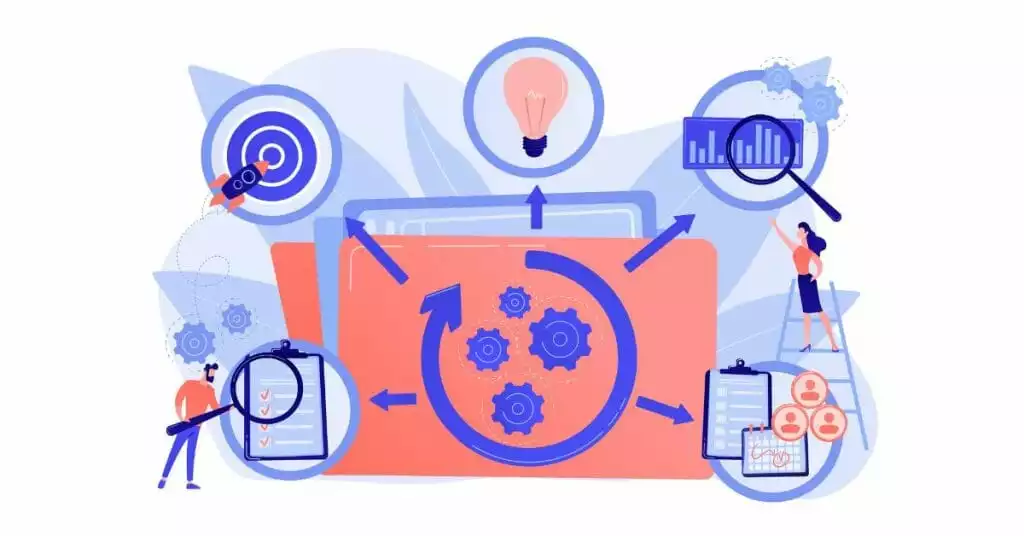CMMI (Capability Maturity Model Integration) is a framework for evaluating and improving the processes used in an organization. It covers various aspects of an organization such as development, acquisition, and service. It is used to assess an organization’s maturity level in specific areas and to help organizations identify areas for improvement.
CMMI in software quality assurance can help organizations increase the efficiency and effectiveness of their software development efforts. The purpose of this blog is to explore CMMI in the context of software quality assurance, examining how organizations can use it to improve the quality of their software and deliver better outcomes for their stakeholders.
Background of CMMI
CMMI is developed by the Software Engineering Institute (SEI) at Carnegie Mellon University. The first version of SEI CMMI was released in 2000, and since then, it has undergone several updates to keep up with the changing needs of organizations. It is widely adopted across various industries, including software development, defense, healthcare, and finance. Before knowing about the significance of CMMI in SAQ, one should get to know some of the terms related to CMMI. Such as-
CMMI Model
The CMMI model’s objectives are to evaluate the maturity of a company and to offer recommendations for process improvement with the aim of producing better products. Additionally, the CMMI model offers a mechanism to estimate an organization’s capacity for risk management. Which ultimately helps a lot in software quality assurance.
CMMI Levels
CMMI levels are a way to measure the maturity level of an organization. In the CMMI model, there are 5 maturity levels categorized by the numbers 1 to 5. Which are-
- Maturity Level 1- Initial,
- Maturity Level 2- Managed,
- Maturity Level 3- Defined,
- Maturity Level 4- Quantitatively Managed,
- Maturity Level 5- Optimizing.
Even though the goal of most organizations is to get to level 5, the model can still be used and is still helpful for organizations that have reached the primary level. Organizations at the primary level focus mostly on maintenance and improvements, but they also have the freedom to work on new ideas and adapt to changes in the industry.
Relation Between CMMI And Software Quality Assurance
CMMI is a framework for improving software development and maintenance processes. Software Quality Assurance (SQA) is a process-oriented approach to evaluating the quality of software throughout its development lifecycle.
Quality is the most important element of any software development process since it guarantees the dependability and efficiency of new software. To guarantee this quality, software quality assurance (SQA) methods and the Capability Maturity Model Integration (CMMI) qualitative metric are both used.
The relationship between CMMI and SQA is that CMMI provides guidance on how to implement software development and maintenance processes, while SQA provides a systematic approach to evaluate and improve the quality of the software being developed and maintained. CMMI can be seen as a framework for managing software development processes, while SQA provides specific techniques for evaluating software quality.

Benefit of Implementing CMMI in Software Quality Assurance
CMMI is a clear and structured approach to improving software development processes. The advantages of implementing CMMI in software quality assurance include:
- Improved process efficiency and effectiveness: CMMI helps organizations to streamline their software development processes, reducing waste and increasing efficiency.
- Better control and predictability: CMMI provides a framework for defining and monitoring software development processes, enabling organizations to better control and predict the outcomes of their software development efforts.
- Enhanced quality: CMMI provides a structured approach to quality assurance, enabling organizations to identify and address potential quality issues before they become problems.
- Increased customer satisfaction: By improving the quality and predictability of their software development processes, organizations can increase customer satisfaction and build stronger relationships with their customers.
- Improved competitiveness: CMMI provides organizations with a framework for continuous improvement, enabling them to stay ahead of the competition and maintain a competitive edge in the marketplace.
Overall, the implementation of CMMI can help organizations improve the quality and efficiency of their software development processes.

Disadvantages of CMMI in Software Quality Assurance
There are both advantages and disadvantages to CMMI. As we discussed the benefits or advantages of CMMI earlier. Let’s now see some of the disadvantages-
- Complexity: Implementing CMMI can be a complex and time-consuming process, requiring significant resources and expertise.
- Cost: Implementing CMMI can be expensive, as it requires significant investments in training, process improvement, and documentation.
- Rigidity: CMMI can be inflexible and may not allow for the incorporation of new or innovative practices, technologies, or methodologies.
- Bureaucracy: CMMI can lead to increased bureaucracy, as organizations are required to maintain extensive documentation and adhere to strict processes.
- Focus on Process: CMMI places a strong emphasis on process, which can lead to a focus on paperwork and process compliance over actual software quality improvement.
- Lack of Customizability: CMMI is a generic model and may not be fully applicable to all organizations, leading to a lack of customizability.
- Maintenance: CMMI requires ongoing maintenance, including regular assessments and process improvements, which can be time-consuming and costly.
Overall, understanding the disadvantages of CMMI can help organizations make informed decisions about how to implement CMMI effectively and realize the maximum benefits of the model.
CMMI Implementation Process in Software Quality Assurance
Steps in CMMI implementation
The implementation process of CMMI in software quality assurance typically involves the following steps:
- Assessment: A preliminary assessment is conducted to determine the current state of the software development processes.
- Process Improvement Planning: A plan for process improvement is developed based on the results of the assessment.
- Process Implementation: The software development processes are implemented and followed according to the plan.
- Process Evaluation: The processes are evaluated to ensure that they are effective and in compliance with CMMI.
- Re-Assessment: A reassessment is conducted to determine the level of maturity achieved through the process improvement effort.
- Continual Process Improvement: The software development processes are continually monitored and improved to maintain compliance with CMMI and achieve higher levels of maturity.
It’s important to note that CMMI implementation requires a significant commitment from the organization, including dedicated resources and management support.

Role Of Process Improvement Teams
The main roles of process improvement teams include:
- The team is responsible for developing a plan for process improvement, implementing the processes, and monitoring their effectiveness.
- The team performs assessments to determine the current state of the software development processes and identify areas for improvement.
- The team works to identify best practices that can be incorporated into the software development processes to improve their effectiveness.
- The team helps to facilitate communication between different stakeholders, including management, developers, and customers.
- The team provides training and education to support the adoption of the software development processes.
- The team is responsible for maintaining accurate and up-to-date documentation of the software development processes.
- The team continually monitors the software development processes and implements improvements to maintain compliance with CMMI and achieve higher levels of maturity.
Overall, the process improvement team is responsible for ensuring that the software development processes are effective, efficient, and aligned with the goals of the organization
Use Of CMMI in Software Quality Assurance
In the context of software quality assurance, CMMI can be used to:
- Identify areas for improvement in the software development process, including quality management, risk management, and project management.
- Establish standard procedures and guidelines for software development, to ensure consistent and high-quality outcomes.
- Provide a framework for continuous process improvement, allowing organizations to continuously monitor and improve their software development processes over time.
- Help organizations meet customer expectations and industry standards for software quality, by demonstrating a commitment to process improvement and quality management.
- Provide a roadmap for software development organizations to follow, with clear goals and milestones for achieving process maturity and improving software quality.
Wrapping Up
In conclusion, by implementing CMMI in software quality assurance, organizations can improve their software quality. It helps them to assess their current processes, identify areas for improvement, and implement best practices to achieve a higher level of maturity in their software development processes.
Organizations can reduce the risk of software failures, improve customer satisfaction, and increase efficiency and productivity with the help of CMMI. Overall, CMMI is a valuable tool for organizations looking to enhance the quality of their software development processes and improve overall software quality assurance.

75 Responses
how to get viagra
Instalación simple y descarga gratuita, no se requieren conocimientos técnicos y no se requiere raíz.Grabacion de llamadas, Grabacion de entorno, Ubicaciones GPS, Mensajes Whatsapp y Facebook, Mensajes SMS y muchas características mas.
Bovada Mobile is designed to suit international player lifestyles and features easy, fast, stable entertainment on mobile and tablet accessible via the Bovada Mobile Sports App easy to use and no download required, the Bovada Mobile Casino App, and the Bovada Mobile Poker App. The advantages and disadvantages to using Bovada are both tied to its status as an offshore sportsbook. Bovada offers a high degree of availability — depending on where you live, it may be your only option for using an established online sportsbook. But it also limits your payout options to cryptocurrency or check by courier, while U.S.-based sportsbooks usually allow you to transfer winnings directly to your bank account. The Bovada sports betting app is completely available on the site. It has a slightly different layout than the desktop version in order to better fit on mobile devices. The good news is that it keeps the same range of sports and markets. It also has a bar at the bottom for easier access to the sports, the live section, and the menu.
https://travisjjhf963963.dbblog.net/52149816/1win-related-apps
The UFC schedule is constantly changing with fighters pulling out, but Rob Font has stepped up to the plate, and it could be a tricky fight for the -350 Sandhagen. Let’s dig into their bout, beginning with the latest betting odds. Betting on the UFC isn’t as popular as betting on other major leagues in the USA, but there are still some fans that prefer betting on the fights. Since sports betting has become legal and many sportsbooks have launched in various US states, the act of betting itself has become quite popular. In this article, we will explain how UFC betting works. Remember, BetUS offers a platform to bet on all UFC fights, along with promotions for new customers, including deposit bonuses. Whether you choose to use cash or cryptocurrencies, BetUS has you covered for your UFC betting needs.
Insightful piece
flagyl alternative
furosemide cirrhosis
zoloft mechanism of action
lisinopril 20 mg tablet
zithromax safe pregnancy
lasix to torsemide
glucophage clomid
gabapentin dose for dogs
can you overdose on escitalopram 10 mg
This page is incredible. The brilliant information reveals the manager’s interest. I’m awestruck and envision further such mind blowing substance.
gabapentin reviews
best antibiotic for sinus infection besides amoxicillin
is cephalexin used for sinus infection
bactrim cause yeast infection
doxycycline and ciprofloxacin
cephalexin 500mg for dogs dosage
how to take bactrim
wellbutrin and escitalopram
natural alternative to gabapentin for nerve pain
can you crush ddavp tablets
citalopram trade name
what is cozaar prescribed for
depakote liquid
ddavp rhinal tube cost
long term side effects of citalopram
cozaar 25mg side effects
depakote extended release
diltiazem xt
ezetimibe hyponatremia
can you drink while taking augmentin
what is diclofenac sodium
lowest dose of contrave
wellbutrin and effexor together side effects
is it safe for women to take flomax
flexeril and weight gain
how long does aspirin stay in your system
allopurinol manufacturer
buy amitriptyline
what is aripiprazole tablets
will augmentin treat a uti
vioxx vs celebrex
side effects bupropion
is baclofen good for back pain
celexa weight loss
celecoxib and alcohol
buspirone interaction with xanax
ashwagandha daily dosage
acarbose farmacodinamia
actos mellГ©khatГЎsok
what medications should not be taken with abilify
how much semaglutide is in ozempic
great article
protonix and alcohol
remeron med
repaglinide interactions
methocarbamol robaxin
where can you buy valtrex
synthroid evening
sitagliptin for heart failure
berberine and spironolactone
ivermectin 0.2mg
tizanidine migraine
tamsulosin liquid
can i take amitriptlyene with voltaren
venlafaxine 75 mg tablets
zofran acetaminophen interaction
zyprexa 5mg side effects
zetia 10 mg
zofran taken with food
wellbutrin phantosmia
how quickly does zyprexa work